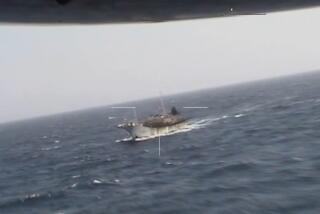Sportfishing Fleet Fears New Limit on Mexico Catch
Every Wednesday and Sunday when the tuna are running off of Baja California, Rancho Santa Margarita resident Roy Moyer packs 30 pounds of tackle and eight fishing rods into his pickup and heads for San Diego, home port of the worldâs largest and most sophisticated oceangoing sportfishing fleet.
With tips, meals and travel expenses included, Moyer spends as much as $250 a day to fish from one of 80 full-time fishing vessels in San Diego that traverse Mexican waters in search of yellowfin, bluefin and prized albacore tuna. On a good day, Moyer will return to port from Mexican waters with several hundred pounds of tuna that deckhands filet and refrigerate for the trip back to Orange County.
But fishing fleet officials are eyeing the upcoming tuna season that begins in July with a wary eye. They are worried that Moyer and thousands of other Southland anglers will be scared away by a new set of sportfishing regulations adopted by Mexican officials.
The rules, adopted in March, effectively limit anglers to just two tuna per day, down from the previous limit of 10. Fleet captains fear that few anglers will be willing to pay hundreds of dollars for fishing trips if their catches are severely limited.
There have been signs in recent weeks, however, that Mexican officials might be willing to relax the rules.
U.S. Rep. Randy (Duke) Cunningham (R-San Diego), who earlier petitioned Mexican President Carlos Salinas de Gortari to adopt less-restrictive regulations, believes that a negotiated settlement could be reached early in June.
Bob Fletcher, president of the San Diego-based Sportfishing Assn. of California, who last week made his third trip to Mexico City to seek a negotiated end to the stalemate, also holds out hope for a compromise.
Cunningham also has tied the fishing regulation to free-trade negotiations that soon will begin between the United States and Mexico. Failure to issue a less-stringent set of regulations âwill be seen as a very negative sign by those who oppose free trade, and rightly so,â Cunningham said.
Officials in Mexico City recently said that the regulations were written after discussions with nearly 100 sportfishing clubs on both coasts in Mexico.
According to figures provided by the Mexican Department of Fisheries, about 400,000 foreign sportsmen--almost exclusively from U.S. ports--fished in Mexican waters during 1990. In March, the former minister of fisheries said sportfishing boats made 18,300 trips into Mexican waters during 1989. Those excursions represented a major loss of foreign exchange for Mexico because few of the boats stopped at Mexican ports, according to the minister.
Fishing fleet officials in San Diego have acknowledged that fishermen are balking at the prospect of spending hundreds of dollars if the new catch limit is not changed.
âIâd have to discontinue my fishing if the limit stands,â Moyer said. âItâs like someone telling you that you can only have a half-teaspoon of Cheerios when you want to eat the whole bowl.â
Moyers, who brokers an annual fishing trip on one San Diego boat, remains wary. Fifteen fishermen who had planned to spend $1,500 each for a nine-day trip that Moyer arranged have âbacked away. . . . They donât want to pay $1,500 and only have 21 fish (the catch limit for a nine-day trip).â
Some observers in the United States and Mexico City believe that the strict regulations were designed to bolster Mexicoâs tourism industry by placing severe restrictions on the San Diego fleet and forcing U.S. anglers to utilize Mexican sportfishing fleets in Cabo San Lucas, Mazatlan and Acapulco.
Others argue that Mexican officials have linked the sportfishing fleet to a bitter debate over a U.S. ban on tuna caught by Mexicoâs commercial tuna-fishing fleet.
Avid fishermen like Stas Vellonakis, general manager of Hawthorne-based Astro Machine Co., a family-owned aerospace industry supplier, believe Mexican officials are trying to win a greater share of the long-range fishing boats that offer trips of five days and longer.
âThey want some of the money,â said Vellonakis, who spends an estimated 100 days a year on fishing boats that sail from San Diego. Vellonakis, who often sails on charter boats that spend 20 days on the water, believes Mexican officials âknow the amount of money made by long-range boats. . . . they want their hands in that.â
But Fletcher said few of the San Diegoâs sportfishing fleetâs customers would be able to pay air fares to Mexican destinations for a simple overnight fishing trip. Mexican resorts and San Diegoâs fishing fleet âare not going after the same customer,â Fletcher said.
Although some observers believe Mexican officials adopted the regulations in order to protect their tuna stock from being depleted, Fletcher disputes claims that sportfishermen are a threat to the species.
The 400 tons to 500 tons of tuna that the San Diego fleet takes each year is a small percentage of what Mexicoâs commercial fishing fleet pulls from the ocean, Fletcher says.
Although the sportfishing fleet has not gathered economic data on its contribution to the San Diego economy, the fleet is recognized as âa significant outdoor recreational attraction,â said Al Reese, spokesman for the San Diego Convention & Visitors Bureau.
âThis is one of the great sportfishing areas in the world . . . and while (fishermen) are a fairly small segment of the total visitor population, they are specifically drawn here by the opportunity to go sportfishing,â Reese said.
The sportfishing fleet, which provides direct employment for an estimated 400 people on the boats and in bait shops and five boat landings, also bolsters other tourist-dependent industries.
âWe can tell when the fleet is doing well,â said Mike Morton, president of Brigantine Corp., which operates two restaurants within walking distance of the sportfishing landing near Rosecrans Street in Point Loma. âThese guys will come in from Arizona or Los Angeles and, typically, theyâll want to get something to eat before they go out on the boat. . . . Itâs a big source of business for us during the summer.â
âWe notice it when (the sportfishing fleet) has a bad year,â Morton said. âSo these regulations will have an effect on our business.â
Hotels in the area also benefit from the crush of fishermen who travel to San Diego from throughout the West. âThe hotels do depend upon us in the summer,â said one boat operator. âWhen we have a good season, they have a good summer.â
The sportfishing fleet also contributes its share of fees and taxes: Based upon 1990 statistics, the fleet would have paid an estimated $1 million to Mexican authorities for licenses had the regulations not been changed.
The three major boat landings that book fishing trips paid nearly $997,000 to the San Diego Unified Port District during 1990. The payments represent a set percentage of the landingsâ gross revenue.
Times staff writer Juanita Darling in Mexico City contributed to this story.
More to Read
Sign up for Essential California
The most important California stories and recommendations in your inbox every morning.
You may occasionally receive promotional content from the Los Angeles Times.










